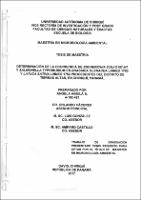Mostrar el registro sencillo del ítem
Determinación de la ocurrencia de Escherichia coli 157:H7 y salmonella typhimurium en Brassica Oleraceae Linneo 1753 y Latuca Sativa Linneo 1753 procedentes del distrito de Tierras Altas, en Chiriquí, Panamá.
| dc.contributor.advisor | Cáceres, Orlando | |
| dc.contributor.author | Aguila, Angela | |
| dc.date.accessioned | 2024-01-08T20:25:13Z | |
| dc.date.available | 2024-01-08T20:25:13Z | |
| dc.date.issued | 2017 | |
| dc.identifier.uri | http://jadimike.unachi.ac.pa/handle/123456789/1048 | |
| dc.description.abstract | El consumo de frutas y hortalizas frescas son de gran importancia y la disponibilidad de estos productos en el mercado local y mundial ha contribuido a un aumento en el consumo diario en la dieta de los habitantes, Cabe mencionar que el actual Incremento reciente de los casos de enfermedades transmitidas por alimentos asociadas a las hortalizas frescas, en especial el repollo y lechuga, ha sido una preocupación entre los organismos de salud pública y los consumidores. En este sentido, elinterés principales la inocuidad de estos productos. Las fuentes y mecanismos de contaminación de las frutas y hortalizas durante su cultivo, cosecha, procesamiento y empacado deben apegarse a prácticas sanitarias para minimizar el riesgo de contaminación por patógenos. Los vegetales son alimentos con una elevada carga bacteriana, no solo porque se cultivan en los suelos, sino también porque se consumen de forma directa, es decir, no se someten a ningún tratamiento previo a la ingesta con capacidad para eliminar posibles patógenos. Como elresto de variedades de coles, elrepollo es una buena fuente de vitamina C y folatos. Aporta cantidades apreciables de potasio, hierro, fósforo y. en menor cantidad, de calcio. También es importante su contenido en fibra (voluble e insoluble), lo que favorece eltránsito intestinaly ayuda a combatir elestreñimiento. además de contribuir a la prevención de diversas enfermedades. La lechuga es extremadamente nutritiva. Es rica en minerales, vitaminas y otros nutrientes esenciales. Consumirla como parte delalimento diario dentro de la comida diaria brindar beneficios para la piel, elcabello y la salud integral. También puede ayudar a resolver problemas se salud. | es_ES |
| dc.description.abstract | The consumption of fresh fruits and vegetables are of great importance. and the availability of these products in the national and global market, has contributed to an increase in daily consumption in the diet of the inhabitants. It should be mentioned that the recent increase in cases of foodborne diseases associated with mesh vegetables, especially cabbage and lettuce, has been a concern among public health agencies and consumers regarding the safety of these products. A prominent pathogen in vegetables and fruits is Salmonella. The sources and mechanisms of contamination of fruits and vegetables during their cultivation, harvesting, processing and packaging must adhere to sanitary practices to minimize the risk of contamination by pathogens. Vegetables are foods with a high bacterial load, not only because they are grown in soils, but also because they are consumed directly, that is, they do not undergo any treatment prior to ingestion with the capacity to eliminate possible pathogens. Like the other varieties of cabbages, cabbage is a good source of vitamin C and folates. It contributes appreciable amounts of potassium, iron, phosphorus and, in smaller quantity, of calcium. Also important is its fiber content (soluble and insoluble). which favors intestinal transit and helps combat constipation, as well as contributing to the prevention of various diseases. The lettuce is extremely nutritious. It is rich in minerals, vitamins and other essential nutrients. Consume it as part of the daily food within the daily meal to provide benefilts for the skin, hair and integral health. It can also help solve health problems. There is no clear explanation of how pathogens such as Listeria monocytgenes, Salmnoella enterica or E. Coli are hooked on the leaves of vegetables The most common bacteria are Salmonella typhy, Listeria monocytogenes, vibirio cholerae, Escherichla coliand Leptospira Interrogans, which cause typhoid fever, gastroenteritis, cholera, diarrhea and leptospirosis, respectively, among other conditions. Salmonella species and Escherichia coli present in lettuce and cabbage from the Highlands area, Chiriqui were identified. For the determination of the presence of these species, samples of cabbage of the varieties Roman. hybrid, beluga, oak leaf and iverna) and lettuce varieties Xerox, improved (Green boyer and Lombard) were used. By means of biochemical and serological tests, twelve strains of Escherichla coli in cabbage and lettuce and thirteen species of Salmonella no enteriditis were identified. Of the Escherichla species found, the enterohemorrhagic variety was not detected. The samples were positive for S. ebterutudus variety typhimurium in all the samples collected. The results rule out the risk of salmonellosis or Hemolytic Uremic Syndrome (HUS) among the consumers of the horticultural products in question. | en_US |
| dc.language.iso | es | es_ES |
| dc.publisher | Universidad Autónoma de Chiriquí. | es_ES |
| dc.subject | ESCHERICHIAS COLI - HORTALIZAS | es_ES |
| dc.subject | SALMONELLA TYPHIMURIUM - REPOLLO Y LECHUGA | es_ES |
| dc.subject | BACTERIAS - AISLAMIENTO Y PURIFICACIÓN -- DISTRITO DE TIERRAS ALTAS PROVINCIA DE CHIRIQUÍ (PANAMÁ) | es_ES |
| dc.subject | TESIS - BIOLOGÍA | es_ES |
| dc.title | Determinación de la ocurrencia de Escherichia coli 157:H7 y salmonella typhimurium en Brassica Oleraceae Linneo 1753 y Latuca Sativa Linneo 1753 procedentes del distrito de Tierras Altas, en Chiriquí, Panamá. | es_ES |
| dc.type | Thesis | es_ES |
Ficheros en el ítem
Este ítem aparece en la(s) siguiente(s) colección(ones)
-
Maestría en Biología [33]

